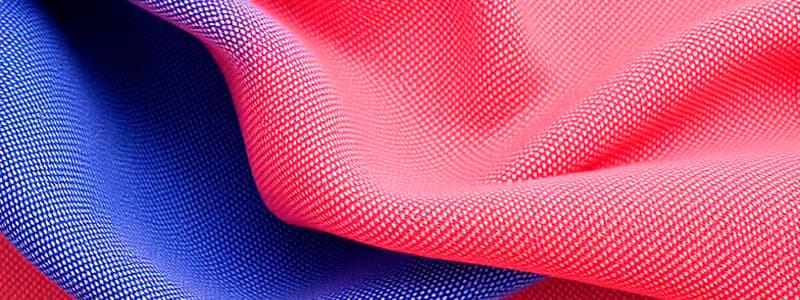Podcast
Questions and Answers
What is a primary consideration when selecting a fabric for a specific purpose?
What is a primary consideration when selecting a fabric for a specific purpose?
- The number of layers in the fabric
- The brand reputation of the fabric
- Its color and pattern
- The specific use and performance requirements (correct)
Which of the following properties might specialized fabrics possess?
Which of the following properties might specialized fabrics possess?
- High elasticity for sportswear
- Thickness for winter clothing
- Bright colors for fashion purposes
- Water resistance for outdoor gear (correct)
What should be taken into account regarding fabric care?
What should be taken into account regarding fabric care?
- Washing, drying, and ironing instructions (correct)
- The fabric's weight and thickness
- How fashionable the fabric is
- The fabric's compatibility with chemical treatments
Why is it important to assess durability when selecting fabric?
Why is it important to assess durability when selecting fabric?
When balancing the cost of fabric selection, which factor should NOT be ignored?
When balancing the cost of fabric selection, which factor should NOT be ignored?
Which factor has the most influence on the fabric's intended use?
Which factor has the most influence on the fabric's intended use?
What is one characteristic that differentiates tightly woven fabrics from loosely woven fabrics?
What is one characteristic that differentiates tightly woven fabrics from loosely woven fabrics?
Which fabric property primarily affects drape and warmth?
Which fabric property primarily affects drape and warmth?
What is not a primary consideration when selecting a fabric?
What is not a primary consideration when selecting a fabric?
Which application is typically not a use of industrial fabrics?
Which application is typically not a use of industrial fabrics?
Which aesthetic preference significantly impacts fabric selection?
Which aesthetic preference significantly impacts fabric selection?
What type of use would most likely prioritize water resistance in fabric?
What type of use would most likely prioritize water resistance in fabric?
Which fiber content is commonly associated with luxurious feel and drape in apparel?
Which fiber content is commonly associated with luxurious feel and drape in apparel?
Which fabric is commonly used for shirts and blouses, providing breathability and comfort?
Which fabric is commonly used for shirts and blouses, providing breathability and comfort?
What type of fabric is typically used for durable pants?
What type of fabric is typically used for durable pants?
Which fabric is NOT commonly associated with dresses?
Which fabric is NOT commonly associated with dresses?
Coats and jackets typically utilize which type of fabric for warmth?
Coats and jackets typically utilize which type of fabric for warmth?
Workwear uniforms are usually made from which type of fabric?
Workwear uniforms are usually made from which type of fabric?
What characteristic is a priority for office wear fabrics?
What characteristic is a priority for office wear fabrics?
Which type of fabric is commonly used for curtains and drapes?
Which type of fabric is commonly used for curtains and drapes?
What fabric is typically utilized in construction and transportation industries?
What fabric is typically utilized in construction and transportation industries?
Flashcards
Fiber Content
Fiber Content
The type of fibers used in a fabric, like cotton, wool, silk, or synthetics. This impacts its feel, durability, and care instructions.
Weave and Structure
Weave and Structure
How fibers are interlaced in a fabric. This creates different surface textures and properties. Tight weaving means more durability; loose weaving means more flexibility.
Weight and Thickness
Weight and Thickness
The heaviness and thickness of a fabric. This impacts drape, warmth, and suitability for different uses. Light fabrics are airy, while heavier fabrics provide warmth and structure.
Color and Design
Color and Design
Signup and view all the flashcards
Purpose of Fabric
Purpose of Fabric
Signup and view all the flashcards
Fabric Performance
Fabric Performance
Signup and view all the flashcards
Fabric Cost
Fabric Cost
Signup and view all the flashcards
Fabric Aesthetics
Fabric Aesthetics
Signup and view all the flashcards
What is the primary purpose of the fabric?
What is the primary purpose of the fabric?
Signup and view all the flashcards
How durable is the fabric?
How durable is the fabric?
Signup and view all the flashcards
What are the fabric's care instructions?
What are the fabric's care instructions?
Signup and view all the flashcards
How much does the fabric cost?
How much does the fabric cost?
Signup and view all the flashcards
What is the fabric's performance?
What is the fabric's performance?
Signup and view all the flashcards
Fabric types for Shirts & Blouses
Fabric types for Shirts & Blouses
Signup and view all the flashcards
Fabric types for Pants & Trousers
Fabric types for Pants & Trousers
Signup and view all the flashcards
Fabric types for Dresses
Fabric types for Dresses
Signup and view all the flashcards
Fabric types for Coats & Jackets
Fabric types for Coats & Jackets
Signup and view all the flashcards
Fabric types for Workwear Uniforms
Fabric types for Workwear Uniforms
Signup and view all the flashcards
Fabric types for Office Wear
Fabric types for Office Wear
Signup and view all the flashcards
Specialized Fabrics for Protective Gear
Specialized Fabrics for Protective Gear
Signup and view all the flashcards
Fabric types for Curtains & Drapes
Fabric types for Curtains & Drapes
Signup and view all the flashcards
Study Notes
Unit Three: Fabric Uses
- Unit covers common fabric uses and workplace fabric identification
- Fabric properties and characteristics affect its suitability
- Fiber content influences feel, durability, and care instructions
- Weave and structure create varying textures and durability
- Weight and thickness determine drape, warmth, and suitability
- Color and design add character, create aesthetics, and convey messages
- Purpose impacts fabric selection
- Apparel fabrics are used in various clothing types
- Home furnishings and textiles include curtains, upholstery, bedding, and rugs
- Workplace fabrics categorized into uniforms, protective gear, and office wear
- Industrial and commercial fabrics used for a wide range of applications
Factors Influencing Fabric Use
- Purpose is a core factor defining intended application
- Includes apparel, home furnishings, and industrial/commercial uses
- Performance factors are crucial (durability, breathability, water resistance) depending on the use
- Cost is an essential consideration, balancing quality and performance requirements
- Aesthetics (color, pattern, and texture) significantly influence selection
Identifying Common Fabric Uses
- Apparel: From everyday wear to couture, fabrics cover a wide range of clothing
- Home furnishings include curtains, upholstery, bedding, and more, enhancing home environments
- Industrial and Commercial fabrics include furniture, car interiors, medical textiles, and packaging materials
Apparel and Clothing Applications
- Shirts/blouses: Cotton, silk, linen, synthetics for breathability, comfort, and style
- Pants/trousers: Durable fabrics like denim, twill, or chinos for durability and style
- Dresses: Lightweight chiffon to luxurious velvet, selected based on occasion and style
- Coats/jackets: Heavier fabrics (wool, leather, fleece) for warmth, durability, and protection
Identifying Fabrics Used in the Workplace
- Uniforms: Durable, easy-to-clean fabrics (cotton, polyester blends, flame-resistant) used for workwear
- Office wear: Fabrics like linen, silk, and cotton blends for comfort, breathability, and a professional look
- Protective gear: Specialized fabrics for heat, abrasion or chemical resistance for safety
Home Furnishings and Textiles
- Curtains and drapes: Fabrics include velvet, silk, linen and cotton for aesthetic appeal, light control and insulation
- Upholstery: Velvet, leather, linen, and microfiber fabrics prioritize durability, comfort and resistance
- Bedding: Fabrics like cotton, linen, silk, and flannel for comfort, breathability, and warmth
- Rugs and Carpets: Wool, cotton, silk, or synthetic fibers for durability, comfort, and aesthetics
Industrial and Commercial Applications
- Industrial Textiles: Heavy-duty fabrics like canvas, nylon, and polyester for construction, agriculture, and transportation
- Technical Textiles: Advanced fabrics with flame-retardant or water-resistant properties used in safety gear and medical fields
- Consumer Products: Fabrics used in everyday items (bags, shoes, accessories) offering both functionality and style
Considerations for Fabric Selection
- Purpose: Understanding the specific use and its performance needs.
- Durability: Fabric's resistance to wear, tear, and fading for long-term use.
- Care instructions: Considering washing, drying, and ironing instructions.
- Cost: Balancing fabric cost with quality, performance, and longevity.
Conclusion and Key Takeaways
- Fabric diversity offers choices for every need.
- Fabrics' functionality and aesthetic appeal shape lives and environments.
- Carefully consider factors like purpose, durability, care instructions, and cost before selection.
Studying That Suits You
Use AI to generate personalized quizzes and flashcards to suit your learning preferences.




